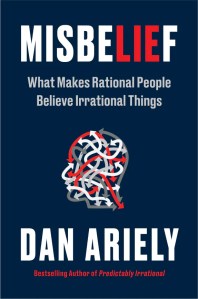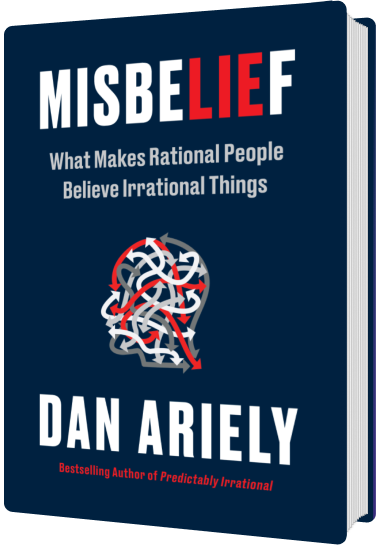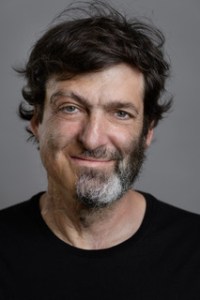A few weeks ago, David French wrote a very compelling and troubling OpEd in the New York Times, under the title: “The Articulate Ignorance of Vivek Ramaswamy.”
The main point focused on a response that Vivek Ramaswamy gave during the Republican debate to the question of whether Mike Pence did the right thing by certifying the presidential election on Jan. 6, 2021. Ramaswamy’s response was that if he was in Pence’s shoes, he would have “pushed for a new federal law to mandate single-day voting, paper ballots and voter identification.”
French then goes on to explain that this is “a crazy, illegal, unworkable idea on every level,” which of course it is. French then continues to wonder how can anyone make such an impractical and impossible statement. This is where French, and I suspect most people, miss an important shift in the current political communication landscape – a shift toward shibboleth.
What is shibboleth? As I explain in my new book MISBELIEF, the modern term shibboleth is based on a biblical story where two tribes, the Ephraimites and the Gileadites, pronounced the word shibboleth differently. After a bloody war between them, when someone tried to cross the river, they asked them to pronounce shibboleth and if the pronunciation was different from their own pronunciation, they person in question was killed. The way that social scientists use the term shibboleth is as a kind of linguistic password that identifies people’s belongingness to a group. This is also the key to better understanding our modern political discourse, and within it also understanding Ramaswamy and his comment.
My guess is that when Ramaswamy proposed his new federal law, he did not really mean it as a real solution to the question. Nor was he adding facts to the discussion. No — he was signaling. Imagine that Ramaswamy would have said something of the republican-run-of-the-mill category. Maybe he would have said that he would have gathered the Republican leadership to discuss the issue. Or maybe that he would have made sure to publicly register his protest. Any such more modest statements would not portray him as a real true Republican leader. They would just portray him as a standard Republican. In contrast, by saying something impossible and outlandish he is using shibboleth and marking himself as a person with the qualities of a true Republican leader.
This is where French was wrong in his analysis because he mistakenly assumed that the goal of Ramaswamy’s response was to communicate a true opinion and not to signal his loyalty and identity and suitability to Republican leadership.
While I hope that this analysis of the role of shibboleth in the current political discourse, this perspective should not give us any comfort and instead it should make us even more worried. In standard communication we expect people to say what they mean, to say the truth and to add facts to the discourse. Especially when the communication is public on well accepted media channels. When shibboleth takes the center stage and these basic assumptions no longer hold, the risk of false narrative increases dramatically.
The challenge with this analysis is that it doesn’t help us figure how to deal with a discussion that pretends to be about real information but is in fact a shibboleth kind of communication. What we need is to approach this problem in two ways: First, we need to understand this shibboleth strategy and figure out how to take some of the things that politicians say and treat them as loyalty statements, and not as informative speech. Second, we need to demand more from our politicians. We need to start having agreed upon standards for political discussions and it is best to set these clearly and before we get too deep into the election season, and ideally before the next debate.
P.S. Obviously, the problem of shibboleth is only limited to US politicians, and in other countries (Israel, UK, Brazil to name just a few) people, politicians, and social media are immune from this problem, but even so, it is useful to understand shibboleth and think about it as we go about consuming and producing information.
–Dan
If you would like to read my new book MISBELIEF, this page includes an option to order a copy for yourself + a copy to be donated to an educator. The book can also be found at Amazon, Bookshop.org, Audible, BAM, or Barnes & Noble.
Hello to All!
Today I am celebrating the release of my new book MISBELIEF: What Makes Rational People Believe Irrational Things. I hope you will find this topic as interesting as I have, and get a book, and learn about what I describe as a psychological machine that influences people’s beliefs and changes them, sometimes in a way that is very difficult to understand. If you are curious about this book, you can learn more about it here and here.
If you decide you want to read the book, this page includes an option to order a copy for yourself + a copy to be donated to an educator. The book can also be found at Amazon, Bookshop.org, Audible, BAM, or Barnes & Noble.
Hello hello,
I am happy to announce that on September 19, 2023, HarperCollins will be publishing my new book MISBELIEF.
In the early Covid days, I had the misfortune to experience first-hand how it feels to be brutally attacked by people who believed that Covid was a plot designed to destroy humanity. One of the results of this experience was my fascination with the process by which people adopt beliefs that are patently untrue about other individuals, the news, and institutions. This book is partly a description of the people and experiences I encountered along my journey. But mostly it’s an explanation of the psychological machine that takes people and changes them in ways that seem difficult to understand. A psychological machine I call “the funnel of misbelief.”
You can learn more about the book here and here. If you decide you want to read the book, this page includes an option to order a copy for yourself + a copy to be donated to an educator. The book can also be found at Amazon, Bookshop.org, Audible, BAM, or Barnes & Noble.
Here are some kind things that people have said:
“In this thoughtful, moving and well-written book, Dan Ariely narrates his personal and professional journey to understand the world of misbelievers and conspiracy theories, and offers insights and tips that will hopefully help all of us protect our fragile social fabric from being torn apart by disinformation and distrust.”
– Yuval Noah Harari, Bestselling author of Sapiens
“Misbelief is an urgent examination of the human attraction to misinformation. This timely book can provide a crucial foundation for building a more empathetic and informed society.”
– Daniel H. Pink, #1 New York Times bestselling author of The Power of Regret
“Once again Dan Ariely writes in a way that gets us to think and reflect about our human nature. In Misbelief, Ariely helps us understand the nature of our opinions, how they’re formed, and how the forces of misinformation can distort them. This is an important book for those who want to understand themselves and the increasingly complex world around us.”
– Arianna Huffington, Founder & CEO, Thrive Global
“For most of us it is tempting to think that people misbelieve things because they are uneducated, unintelligent, or misinformed. But as one of the world’s leading scientists studying beliefs, Dan Ariely, convincingly demonstrates in this important book (and as he discovered first hand in being wrongly accused of leading a nefarious conspiracy!), Misbelief is a process to which any of us can fall prey. More importantly, he offers science-based suggestions on what we can do about the polarization and breakdown in trust that comes with Misbelief.”
– Michael Shermer, Publisher Skeptic magazine and author of Conspiracy: Why the Rational Believe the Irrational
I hope you enjoy the book.
Irrationally yours,
Dan
David Pitt reviews my new book in this month’s edition of Booklist.
Misbelief: What Makes Rational People Believe Irrational Things.
By Dan Ariely.
Sept. 2023. 320p. Harper, $32 (9780063280427). 300.Social scientist Ariely (Irrationally Yours, 2015; Dollars and Sense, 2017) has spent years focusing on the way we often embrace ideas that are irrational, and here he turns his at- tention to misinformation specifically. Based in part on the author’s own experiences as the target of deliberate disinformation—with seemingly rational people believing lies about him—the book is an insightful examination of the underlying psychological factors that bolster misinformation’s appeal. It covers our natural tendency to accept ideas that reinforce our own beliefs (and to dismiss those that contradict them), and the way the spread of misinformation is reshaping our society. Ariely is a persuasive writer, offering plenty of anec- dotal examples to bolster his arguments and show how misinformation alters people’s lives. It’s a rigorous but also deeply compassionate book: Ariely’s goal isn’t to condemn people who fall for misinformation, but to show the reader how easy it is to believe the irrational. The book asks us to foreground empathy to reexamine some of our own beliefs. For some readers, the results could be eye-opening. —David Pitt
Full link to Booklist: https://booklist.booklistonline.com/html5/reader/production/default.aspx?pubname=&edid=6d2991a4-9d82-4321-9c01-8a678a578755
My new book MISBELIEF will be out on September 19th! You can pre-order it here https://misbeliefbook.com.
I have a new video introducing my new book!
Or you can view it on YouTube.
The book will be out on September 19th, but you can pre-order it here https://misbeliefbook.com
Check out my latest book! Out on September 19th, but you can pre-order it starting today!
MISBELIEF: What Makes Rational People Believe Irrational Things.
During the darkest early days of the pandemic, I was demonized by online misbelievers who falsely accused me of being a mastermind behind universal mask mandates and the chief engineer of the “Covid-19 fraud.” Attempts to explain my position to my attackers only escalated their vehement declarations. The experience, as disturbing and devastating as it was, inspired me to dig into the innate origins of these people’s unfounded and immovable convictions.
More generally, in recent years, we have more frequently been confronted with the outlandish conspiracy-laden misbeliefs of those around us. Even close family and friends may freely spout misinformation that gives us pause. Under the right circumstances, anyone can become a misbeliever.
In this book, I analyze the psychological machinery that changes beliefs to such an extent that people no longer trust media, institutions, and health systems. The four main elements of this psychological machinery are:
- Pressure, stress, and resentment over perceived mistreatment are key emotional factors—and at the center of many misbelievers’ journeys that began during the pandemic.
- Our rational capacities can be used in highly irrational ways to form and confirm beliefs. We think we are information machines that objectively take in information, record it, analyze it, and come to logical conclusions. But nothing could be farther from the truth. We have evolved a complex, sometimes sophisticated, sometimes flawed, and sometimes downright faulty set of shortcuts for processing the often-overwhelming world we live in.
- Many of the mechanisms that draw people into the funnel of misbelief are common human characteristics. Yet not all human beings are equally susceptible. Our individual differences— our personalities—play a role. Why are some people more susceptible than others? Individual differences and certain personality traits such as patternicity, the tendency to trust one’s intuitions, certain decision-making biases, and narcissism add to the picture.
- Social forces are at work at every stage of a misbeliever’s progression. Even the slightest degree of ostracism by family and friends can loom large in the consciousness of someone who is taking their first steps into misbelief, pushing them more forcefully into the funnel. The sense of being welcomed, acknowledged, heard, respected, and praised by fellow misbelievers creates a powerful pull of belonging. Social forces accelerate misbelief, driving people to embrace more extreme positions in order to prove loyalty and gain status. Fear of social rejection or ostracism make it very hard for them to change their beliefs once again.
Even in a time when artificial intelligence can generate convincing fake news that feeds misbelief, there is hope. There are many things we can do to mitigate the problem, and there are many more things we don’t know what to do about—yet. What is certain is that the strategies to help combat misbelief will have to be rooted not in conflict, but in understanding and empathy. The sooner we recognize that this is above all else a human problem, the sooner we can become the solution to misbelief.
If you are interested in this topic, and I think that you should be, order the book here: https://misbeliefbook.com
Well, it turned out I can’t claim full credit for the ‘Half Beard look’ (no patent for me). A friend of mine, who was visiting the Sigmund Freud Museum in Vienna, sent me the above Man Ray’s self-portrait, which was taken in 1943, when Man Ray was in his fifties.
Man Ray (originally: Emmanuel Radnitzky ) was an American artist who contributed to the Surrealist and the Dada movements. In reading about him I discovered that he sought to keep his personal background far from the public’s eye, even refusing to reveal he was born under a different name. Man Ray moved to Paris in 1921 and lived there until the second world war, when he returned to the States. In 1951, he returned to Paris, where he worked until his death in 1976.
“Man Ray’s self-portrait Before and After takes a humorous view. With half of his face shaved, the artist presents himself to the viewer as a sort of Dr. Jekyll and Mr. Hyde, raising question: Which side of the portrait corresponds most to the subject’s personality? It depicts both past and future events, or rather, the period of time in between that documents what has already-happened as well as that which is yet-to-come.”
Francis Naumann (art dealer, scholar, and curator specializing in Dada and Surrealist art) suggested that shaving half of his face has a connection to his Europe/USA divided identity.
I have a hard time typing because of my injuries. I have tried all kinds of things over the last few years. I asked Ray to help me by writing a piece of software that helps me to record voice notes and send them over e-mail – Either as original e-mail, or as responses to e-mail.
I find it incredible useful! It’s called Vail and we just made the software available online. Note that it only works for Apple Mail on a Mac.
If you want to see it in action, look at the video in this link. Instructions for how to download the software are in the notes under the video. I hope you will find it as useful as I do.

 Tweet
Tweet  Like
Like 
